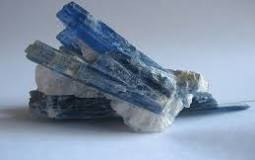
Kyanite: The Blade of Alignment in the Raw Crystal Realm
From shimmering indigo shards to ethereal silver-blue blades, Kyanite is one of the most striking and energetically unique minerals in the world of crystal healing. Beloved by collectors, healers, and jewellery artisans alike, this stone is revered for its unshakeable calm, chakra-aligning energy, and unmistakable aesthetic presence—especially in its raw, natural form.
In this in-depth guide, we’ll explore Kyanite’s geological makeup, metaphysical qualities, and why it holds such a special place within the world of mineral specimen jewellery.

The Geological Identity of Kyanite
Kyanite is an aluminium silicate mineral, chemically classified as Al₂SiO₅. It forms primarily through high-pressure metamorphic processes, often found in schist and gneiss rock formations. What makes Kyanite geologically fascinating is its anisotropic hardness—meaning it has two different hardness ratings depending on the direction in which it’s scratched: typically around 4.5 parallel to its length, but up to 7 across the width.
Kyanite crystallises in the triclinic crystal system, most often presenting as elongated, blade-like formations—hence its nickname, “crystal swords” or “spirit blades”. These structures make it ideal for energetic use and equally dramatic when left in its raw state for jewellery applications.
Colours & Varieties
Though best known for its deep, electric blues, Kyanite can also occur in:
-
Green (associated with the heart chakra)
-
Black (more grounding, found in Brazil)
-
Orange (a rarer sacral-activating form)
-
Colourless or grey-silver (a high-vibration variant)
High-quality blue Kyanite is commonly sourced from Nepal, Brazil, Switzerland, and USA, though striking specimens also emerge from India, Kenya, and Russia.
Metaphysical Properties & Healing Energies
Kyanite is unique among crystals for not retaining negative energy and therefore never requires cleansing. This self-cleaning quality makes it a favourite among both beginners and seasoned crystal workers.
Primary Energetic Qualities:
-
Chakra Alignment – Often associated with the throat chakra, blue Kyanite supports clear communication, truth-telling, and vocal confidence. However, it is also regarded as a “bridge stone” that aligns all chakras, creating energetic coherence throughout the body.
-
Mental Clarity & Psychic Ability – Kyanite sharpens intuition, facilitates lucid dreaming, and enhances meditative depth. Its sword-like shape is seen symbolically as cutting through illusion.
-
Emotional Soothing – It is a deeply calming crystal, ideal for those experiencing emotional overwhelm or energetic fragmentation.
-
Energetic Boundaries – Particularly the black variety is prized for protecting the auric field from intrusion or depletion.
A Collector's Delight: The Unrefined Appeal
Kyanite’s raw blade-like form, often layered in shimmering blue stacks or standing as individual crystal swords, is captivating. Unlike polished stones that smooth over the rugged narrative of formation, raw Kyanite retains a powerful sense of geological history. Each ridge and vein speaks of millions of years of pressure and transformation.
This makes it a treasured mineral specimen in both educational collections and energetic spaces. The anisotropic structure adds a layer of fascination for geologists and metaphysicians alike—its form naturally suggesting flow, direction, and movement.
Kyanite in Historical and Cultural Lore
While Kyanite does not have as extensive a historical or mythological record as some stones like Lapis Lazuli or Turquoise, it has gained reverence in modern metaphysical traditions. Some spiritual communities refer to it as the "Archangel Michael’s Sword", symbolic of divine truth and protection.
Indigenous and shamanic traditions have occasionally adopted Kyanite in ritual tools due to its alignment properties and its ability to retain purity. It is also increasingly used in modern-day crystal grids and healing circles for its chakra-bridging qualities.
Kyanite in Comparison: A Singular Energy Signature
Unlike many crystals that need regular cleansing (like Selenite or Quartz), Kyanite’s standout feature is its non-retentive nature—it does not absorb or hold negativity. This makes it especially practical for everyday use in jewellery, particularly when worn near the throat, third eye, or heart.
Compared to Similar Crystals:
-
Blue Apatite – While both enhance communication, Apatite is more motivating and goal-oriented, whereas Kyanite is meditative and aligning.
-
Sodalite – Shares the theme of truth-telling but is more cerebral and less energetically aligned across all chakras.
-
Labradorite – A mystical shield, but more introspective and protective rather than harmonising.

The Art of Raw Kyanite in Jewellery
There’s something distinctly primal and elegant about raw Kyanite in mineral specimen jewellery. The natural bladed structure, with its shimmering, layered striations, creates visual drama and symbolic depth when used in:
-
Crystal specimen rings – Slender slivers of Kyanite on adjustable bands evoke both precision and elegance.
-
Mineral specimen necklaces – Often set with minimal bezel or simply drilled to preserve the wild beauty.
-
Handmade gemstone earrings – Especially when paired with complementary stones like moonstone or quartz points.
Each piece serves as an energetic anchor for alignment and calm communication—ideal for both spiritual practitioners and those seeking elegant, purposeful adornment.
At Oryssia, we honour this natural drama by working only with uncut or minimally worked Kyanite blades, preserving the raw frequency and directional energy of the mineral.